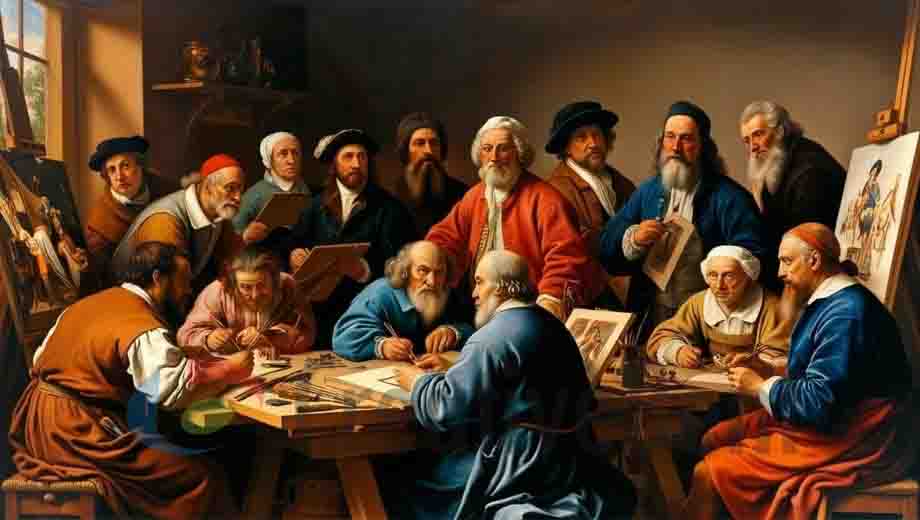
Throughout history, some of the most renowned European Masters of the world have been nurtured and inspired in Europe, which has long been a cradle of artistic genius. The European continent has produced a rich tapestry of cultural movements and personalities, from Renaissance geniuses to Baroque virtuosos and Romantic visionaries. Art enthusiasts can explore the depths of human ingenuity and the development of artistic expression across time by setting out on a quest to find the works of these revered masters.
A View of Creative Traditions
European art is seductive due to its outstanding beauty as well as its historical significance. Each period produced outstanding artists who left a lasting impression on the art world. European masters have influenced the development of art history in various ways, from Michelangelo’s breathtaking frescoes in the Sistine Chapel to Van Gogh’s deeply moving paintings.
Art’s resurgence during the Renaissance
Many great artists emerged during the Renaissance, a time of cultural renewal in Europe, including Leonardo da Vinci, Raphael, and Titian. These artists explored anatomy, perspective, and realism as they revolutionized artistic processes. Incomparable beauty and accuracy were used to capture the heavenly and human forms in their creations.
Dramatic Extravagance of the Baroque: Emotion
Dramatic fervor and emotional fervor flourished during the Baroque period. Chiaroscuro is a technique painters like Caravaggio and Rembrandt employ to produce startling contrasts between light and shade. Their works have a dramatic quality that moves the soul with their moving tales.
Classicism and Neoclassicism in the Age of Enlightenment
The Age of Enlightenment witnessed a return to classical ideas, and artists such as Jacques-Louis David and Antonio Canova adopted neoclassical concepts. Their writings reflected the philosophical currents of the day and praised reason, virtue, and the magnificence of previous civilizations.
Recognizing Emotion and Nature in Romantic Visionaries
Artists in the Romantic era revolted against neoclassical conventions, looking to emotion, nature, and the paranormal for inspiration. The magnificent landscapes of J.M.W. Turner and the passionate brushstrokes of Eugène Delacroix captured viewers’ attention with their emotional intensity as they represented the essence of Romanticism.
A Revolution in Perception: Impressionism
The introduction of Impressionism in the late 19th century revolutionized art. Pioneers like Claude Monet, Pierre-Auguste Renoir, and Edgar Degas defied conventional academic rules by painting brief moments with a novel use of light and color.
Beyond the Surface of Post-Impressionism
Building on the Impressionist trend, post-impressionists like Vincent van Gogh, Paul Cézanne, and Paul Gauguin explored emotion, symbolism, and abstraction. They pioneered contemporary art with their audacious use of color and shape.
The Whiplash Lines of Nature in Art Nouveau
Gustav Klimt, Alphonse Mucha, and René Lalique were the movement’s leaders as they embraced organic forms and ornamental patterns. The decorative arts have greatly benefited from their appealing designs, which decorate jewelry, architecture, and illustrations.
Expressionism: Transmitting Inner Emotions
Expressionism originated as an introspective trend, with painters like Edvard Munch and Egon Schiele using their paintings to communicate their inner turmoil and unedited feelings. Their pieces force spectators to confront the complexities of the human psyche.
Surrealism: Key to the Unconscious
Salvador Dalí and René Magritte led a group of surrealist artists that explored the unconscious to produce ethereal and dreamlike work. Their creations pushed the boundaries of reality and drew spectators into a bizarre and enigmatic universe.
Accepting gestural abstraction in abstract expressionism
Abstract expressionism emerged in the mid-1900s, when artists such as Jackson Pollock and Willem de Kooning used non-representational shapes and gestural abstraction. Their works of art radiated a sense of unbridled energy and emotional intensity.
The Treasures of Masterpieces in European Museums
The classic works of European masters are housed in the museums of Europe, which are true treasure troves. A few of the institutions that provide an immersion into the realm of art history are the Louvre in Paris, the Uffizi Gallery in Florence, and the Prado Museum in Madrid.
Following the Lead of Masters on an Artistic Pilgrimage
The chance to view masterpieces in their original settings can only be had when making a trip around Europe. Every location, from the Rijksmuseum in Amsterdam to the Vatican Museums in Rome, provides a window into the brilliance of European masterpieces.
From the past to the present: The Evolution of Art
Follow the steps of the European masters to see how artistic techniques and styles have changed over time. European history unfolds before one’s eyes, from the masterfully crafted Middle Ages to the daring innovation of modern art.
Architecture and artwork together harmoniously
The cultural legacy of Europe includes breathtaking architecture in addition to paintings, sculptures, and other visual arts. Art and architecture come together to create a beautiful visual landscape, from the Gothic cathedrals of Chartres to the modernist structures of Barcelona.
Art’s role in preserving cultural identity
For the preservation of European cultural identity, art has been extremely important. European art represents the distinctive cultural fabric of each country, from regional art styles like Dutch genre painting to iconic national emblems like the Mona Lisa.
Future Generations Can Draw Inspiration from the Legacy of European Masters
The legacy of the great European artists continues to inspire artists around the globe. Both budding artists and seasoned experts can find inspiration in their cutting-edge methods, imaginative ideas, and devotion to their trade.




